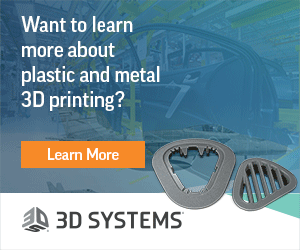 Interest in 4D printing has continued to grow as scientists have expanded their research into creating items and materials that are helpful to research (as well as many other industries, to include fashion) as they adapt to their surroundings, often changing and then reverting back to their original form.
Interest in 4D printing has continued to grow as scientists have expanded their research into creating items and materials that are helpful to research (as well as many other industries, to include fashion) as they adapt to their surroundings, often changing and then reverting back to their original form.
Now, a study by Marius Wagner, Tian Chen, and Kristina Shea of the Swiss Federal Institute of Technology Zurich (ETH Zurich) outlines how shape memory polymers can be the catalyst for producing adaptable materials that also go back to their original shape when heated. Their research explains how they used the following:
- 3D printing
- Thermoviscoelastic meta-materials
- Programmable design
 With their new method, the scientists show that not only can these materials adapt and revert, but they can exhibit changes in area up to two hundred percent. This is all explained in ‘Large Shape Transforming 4D Auxetic Structures.’ The article explains how complex geometries morph due to heat-activated changes. These 3D printed auxetic meta-materials expand into the 4D realm ‘based on thermoviscoelastic material properties obtained by experimental characterization.’ According to the scientists, 4D printing allows for time to act as the fourth dimension.
With their new method, the scientists show that not only can these materials adapt and revert, but they can exhibit changes in area up to two hundred percent. This is all explained in ‘Large Shape Transforming 4D Auxetic Structures.’ The article explains how complex geometries morph due to heat-activated changes. These 3D printed auxetic meta-materials expand into the 4D realm ‘based on thermoviscoelastic material properties obtained by experimental characterization.’ According to the scientists, 4D printing allows for time to act as the fourth dimension.
“4D printing has large untapped potential in applications where configuration change cannot be manually achieved and where electromechanical actuation is not feasible, for example, in aerospace and in medical fields,” state the researchers in their paper. “In addition, 4D designs have the advantage of volume and support reduction.”
Such experimentation has been challenging in past projects by other researchers. The team examined these issues closely, and decided to implement material that could be ’tiled to form active structures.’ They were able to create more accurate design through their programming—and focused heavily on more simplified procedures.
“To simplify the fabrication process, the proposed meta-materials consist of a single material. They can be fabricated with inexpensive inkjet printing processes using commercially available materials. This also broadens the potential for fabricating 4D designs for a variety of applications,” states the team in their paper.

Method procedure. (a) Experimental material characterization. (b) Constitutive model. (c) Finite-element simulation and validation by comparison to experiments. (d) Design of active structures. (e) Design simulation by reduced modeling approach and testing.
The scientists used a Stratasys Objet500 Connex3 3D printer for creating the necessary meta-materials, fabricated with VeroWhitePlus RGD835. They tested four different parameters:
- Glass transition temperature Tg
- The fully relaxed modulus
- The coefficient of thermal expansion (CTE)
- Frequency sweeps of the storage modulus at different temperatures

Shape transformation of active structures. Left column: programmed state, middle column: intermediate state, right column: permanent state. Active auxetic structures: reentrant honeycomb expansion (a), reentrant honeycomb shrinkage (b), anti-tetrachiral honeycomb expansion (c). Scale bars represent 10 mm.
The three point bending experiment was then performed to test the shape memory, and compared to other simulations using the same material model. According to the researchers, temperature was used as input for the specimen temperature in the finite element simulation.
“For simulation of the meta-materials, we adapt a viscoelastic constitutive model with data from thermoviscoelastic material characterization experiments. The accuracy of the model is shown with a three-point bending test. To reduce computational effort, a reduced beam model is constructed to predict forces and deformations of complex active structures. To demonstrate that the meta-materials can conform to a given boundary, a letter based structure is fabricated and programmed into a circular shape. Simulation results confirm the behavior,” concluded the researchers.
Read more about this innovative research here.
What do you think of this news? Let us know your thoughts! Join the discussion of this and other 3D printing topics at 3DPrintBoard.com or share your thoughts below.
[Source / Images: Large Shape Transforming 4D Auxetic Structures]
Subscribe to Our Email Newsletter
Stay up-to-date on all the latest news from the 3D printing industry and receive information and offers from third party vendors.
You May Also Like
Further Understanding of 3D Printing Design at ADDITIV Design World
ADDITIV is back once again! This time, the virtual platform for additive manufacturing will be holding the first-ever edition of ADDITIV Design World on May 23rd from 9:00 AM –...
3D Printer Maker EVO-tech Reborn as NEVO3D — Once More With Feeling
EVO-tech was a 3D printing service and original equipment manufacturer established in 2013 and based in Schörfling am Attersee, Austria. The company produced high-quality material extrusion systems featuring linear bearings,...
3D Systems Brings 3D Printed PEEK Cranial Implant to the U.S. with FDA Clearance
For more than 10 years, 3D Systems (NYSE:DDD) has worked hand-in-hand with surgeons to plan over 150,000 patient-specific cases, and develop more than two million instruments and implants from its...
CDFAM Returns to Berlin for Second Annual Symposium
The second CDFAM Computational Design Symposium is scheduled for May 7-8, 2024, in Berlin, and will convene leading experts in computational design across all scales. Building upon the first event...































